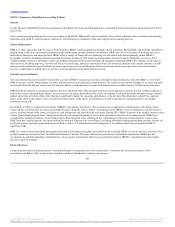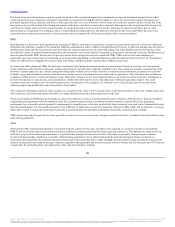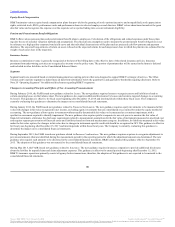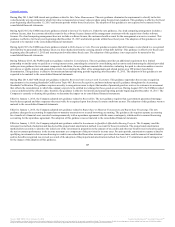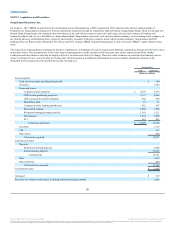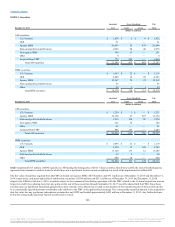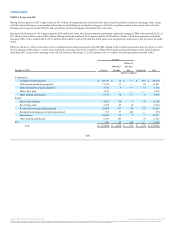BB&T 2015 Annual Report Download - page 108
Download and view the complete annual report
Please find page 108 of the 2015 BB&T annual report below. You can navigate through the pages in the report by either clicking on the pages listed below, or by using the keyword search tool below to find specific information within the annual report.
TableofContents
During May 2015, the FASB issued new guidance related to Fair Value Measurement. The new guidance eliminates the requirement to classify in the fair
value hierarchy any investments for which fair value is measured at net asset value per share using the practical expedient. This guidance is effective for fiscal
years beginning after December 15, 2015 and interim periods within those fiscal years. The adoption of this guidance is not expected to be material to the
consolidated financial statements.
During April 2015, the FASB issued new guidance related to Internal-Use Software. Under the new guidance, if a cloud computing arrangement includes a
software license, then the customer should account for the software license element of the arrangement consistent with the acquisition of other software
licenses. If a cloud computing arrangement does not include a software license, the customer should account for the arrangement as a service contract. This
guidance is effective for fiscal years beginning after December 15, 2015 and interim periods within those fiscal years. The adoption of this guidance is not
expected to be material to the consolidated financial statements.
During April 2015, the FASB issued new guidance related to Debt Issuance Costs. The new guidance requires that debt issuance costs related to a recognized
debt liability be presented in the balance sheet as a direct deduction from the carrying amount of that debt liability. This guidance is effective for fiscal years
beginning after December 15, 2015 and interim periods within those fiscal years. The adoption of this guidance is not expected to be material to the
consolidated financial statements.
During February 2015, the FASB issued new guidance related to Consolidation. The new guidance provides an additional requirement for a limited
partnership or similar entity to qualify as a voting interest entity, amending the criteria for consolidating such an entity and eliminating the deferral provided
under previous guidance for investment companies. In addition, the new guidance amends the criteria for evaluating fees paid to a decision maker or service
provider as a variable interest and amends the criteria for evaluating the effect of fee arrangements and related parties on a VIE primary beneficiary
determination. This guidance is effective for interim and annual reporting periods beginning after December 15, 2015. The adoption of this guidance is not
expected to be material to the consolidated financial statements.
During May 2014, the FASB issued new guidance related to Revenue from Contracts with Customers. This guidance supersedes the revenue recognition
requirements in Accounting Standards Codification Topic 605, Revenue Recognition, and most industry-specific guidance throughout the Accounting
Standards Codification. The guidance requires an entity to recognize revenue to depict the transfer of promised goods or services to customers in an amount
that reflects the consideration to which the company expects to be entitled in exchange for those goods or services. During August 2015, the FASB provided
a one-year deferral of the effective date; therefore, the guidance is effective for interim and annual reporting periods beginning after December 15, 2017. The
Company is currently evaluating this guidance to determine the impact on its consolidated financial statements.
Effective January 1, 2015, the Company adopted new guidance related to Receivables. The new guidance requires that a government guaranteed mortgage
loan be derecognized and that a separate other receivable be recognized upon foreclosure if certain conditions are met. The adoption of this guidance was not
material to the consolidated financial statements.
Effective January 1, 2015, the Company adopted new guidance related to Repurchase-to-Maturity Transactions and Repurchase Financings. The new
guidance changes the accounting for repurchase-to-maturity transactions to secured borrowing accounting. The guidance also requires separate accounting
for a transfer of a financial asset executed contemporaneously with a repurchase agreement with the same counterparty, which results in secured borrowing
accounting for the repurchase agreement. The adoption of this guidance was not material to the consolidated financial statements.
Effective January 1, 2015, the Company adopted new guidance related to Investments in Qualified Affordable Housing Projects. The Company used the
retrospective method of adoption and has elected the proportional amortization method to account for these investments. The proportional amortization
method allows an entity to amortize the initial cost of the investment in proportion to the amount of tax credits and other tax benefits received and recognize
the net investment performance in the income statement as a component of the provision for income taxes. For prior periods, amortization expense related to
qualifying investments in low income housing tax credits was reclassified from other income to provision for income taxes, and the amount of amortization
and tax benefits recognized was revised as a result of the adoption of the proportional amortization method. See Note 14 “Commitments and Contingencies”
for the impact of the adoption of this guidance.
97
Source: BB&T CORP, 10-K, February 25, 2016 Powered by Morningstar® Document Research℠
The information contained herein may not be copied, adapted or distributed and is not warranted to be accurate, complete or timely. The user assumes all risks for any damages or losses arising from any use of this information,
except to the extent such damages or losses cannot be limited or excluded by applicable law. Past financial performance is no guarantee of future results.


